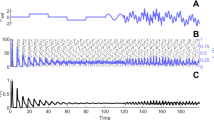Abstract
Coupled oscillator models use a single phase variable to approximate the voltage oscillation of each neuron during repetitivefiring where the behavior of the model depends on the connectivityand the interaction function chosen to describe the coupling. Weintroduce a network model consisting of a continuum of theseoscillators that includes the effects of spatially decaying coupling and axonal delay. We derive equations for determining the stability of solutions and analyze the network behavior for two different interaction functions. The first is a sine function, and the second is derived from a compartmental model of a pyramidal cell.In both cases, the system of coupled neural oscillators can undergo a bifurcation from synchronous oscillations to waves.The change in qualitative behavior is due to the axonal delay,which causes distant connections to encourage a phase shift between cells. We suggest that this mechanism could contribute to the behavior observed in several neurobiological systems.
Similar content being viewed by others
References
Barkai E, Hasselmo ME (1994) Modulation of the input/output function of rat piriform cortex pyramidal cells. Journal of Neurophysiology 72:644–658.
Bower JM (1995) Reverse engineering the nervous system: an in vivo, in vitro, and in computo approach to understanding the mammalian olfactory system. In: S Zornetzer, J Davis, C Lau, eds., An Introduction to Neural and Electronic Networks, Academic Press, New York, pp. 3–28.
Bower JM, Beeman D (1995) The Book of GENESIS: Exploring Neural Models with the GEneral NEural Simulation System. Telos/Springer, Santa Clara, CA.
Carr CE (1993) Processing of temporal information in the brain. Annual Reviews in Neuroscience16:223–243.
Cohen A, Ermentrout GB, Kiemel T, Kopell N, Sigvardt KA, Williams TL (1992) Modeling of intersegmental coordination in the lamprey central pattern generator for locomotion. Trends in Neuroscience15:434–438.
Eeckman FH, Freeman WJ (1990) Correlations between unit firing and eeg in the rat olfactory system. Brain Research528:238–244.
Engel AK, König P, Kreiter AD, Singer W (1991) Interhemispheric synchronization of oscillatory responses in cat visual cortex. Science 252:1177–1179.
Ermentrout GB (1996) Type I membranes, phase resetting curves, and synchrony. Neural Computation8:979–1001.
Ermentrout GB, Kopell N (1984) Frequency plateaus in a chain of weakly coupled oscillators. SIAM Journal on Mathematical Analysis 15:215–237.
Ermentrout GB, Kopell N (1990) Oscillator death in systems of coupled neural oscillators. SIAM Journal of Applied Mathematics 50:125–146.
Ermentrout GB, Kopell N (1991) Multiple pulse interactions and averaging in systems of coupled neural oscillators. Journal of Mathematical Biology29:195–217.
Ermentrout GB, Kopell N (1994) Inhibition produced patterning in chains of coupled nonlinear oscillators. SIAM Journal on Applied Mathematics54:478–507.
Freeman WJ (1978) Spatial properties of an EEG event in the olfactory bulb and cortex. Electroencephalography and Clinical Neurophysiology 44:586–605.
Golomb D, Hansel D, Sompolinsky H (1992) Clustering in globally coupled phase oscillators. Physical Review A45:3516–3530.
Gray CM (1994) Synchronous oscillations in neuronal systems: mechanisms and functions. Journal of Computational Neuroscience 1:11–38.
Gray CM, König P, Engel AK, Singer W (1989) Oscillatory responses in cat visual cortex exhibit inter-columnar synchroniztion which reflects global stimulus properties. Nature338:334–337.
Haberly LB (1985) Neuronal circuitry in olfactory cortex: anatomy and functional implications. Chem. Senses10:219–238.
Hansel D, Mato G, Meunier C (1993) Clustering and slow switching in globally coupled phase oscillators. Physical Review E, 48:3470–3477.
Hansel D, Mato G, Meunier C (1995) Synchrony in excitatory neural networks. Neural Computation7:192–210.
Hasselmo ME, Bower JM (1992) Cholinergic suppression specific to intrinsic not afferent fiber synapses in rat piriform (olfactory) cortex. Journal of Neurophysiology67:1222–1229.
König P, Schillen TB (1991) Stimulus-dependent assembly formation of oscillatory responses: I. Synchronization. Neural Computation 3:155–166.
Kopell N, Ermentrout GB (1986) Symmetry and phaselocking in chains of weakly coupled oscillators. Communications on Pure and Applied Mathematics39:623–660.
Kopell N, Zhang W, Ermentrout GB (1990) Multiple coupling in chains of oscillators. SIAM Journal on Mathematical Analysis, 21:935–953.
Kuramoto Y (1984) Chemical Oscillations, Waves, and Turbulence. Springer, New York.
Mastronade DN (1987) Two classes of single-input X-cells in cat lateral geniculate nucleus. i. receptive field properties and classification of cells. Journal of Neurophysiology57:357–380.
Olsen JF, Suga N (1991) Combination-sensitive neurons in the medial geniculate body of the mustached bat: encoding of target range information. Journal of Neurophysiology65:1275–1296.
Pinsky PF, Rinzel J (1994) Intrinsic and network rhythmogenesis in a reduced Traub model for CA3 neurons. Journal of Computational Neuroscience1:39–60.
Rinzel J, Ermentrout GB (1992) Analysis of neural excitability. In Koch C, Segev I, eds. Methods in Neuronal Modeling, The MIT Press, Cambridge, MA, pp. 135–169.
Ritz R, Gerstner W, Fuentes U, van Hemmen JL (1994) A biologically motivated and analytically soluble model of collective oscillations in the cortex ii. application to binding and pattern segmentation. Biological Cybernetics71:349–358.
Traub RD, Wittington MA, Stanford IM, Jefferys JGR (1996) A mechanism for generation of long-range synchronous fast oscillations in the cortex. Nature383:621–624.
Traub R, Wong R, Miles R, Michelson H (1991) A model of a CA3 hippocampal pyramidal neuron incorporating voltage-clamp data on intrinsic conductances. Journal of Neurophysiology66:635–649.
Vanier MC, Bower JM (1995) A comparison of automated parameter-searching methods for neural models. In JM Bower. Computational Neuroscience, Academic Press, pp. 477–482.
van Vreeswijk C, Abbott LF, Ermentrout GB (1994) When inhibition not excitation synchronizes neural firing. Journal of Computational Neuroscience1:313–322.
Wang XJ, Rinzel J (1993) Spindle rhythmicity in the reticularis thalami nucleus: Synchronization among mutually inhibitory neurons. Neuroscience53:899–904.
Waxman SG (1975) Integrative properties and design principles of axons. International Reviews in Neurobiology18:1–40.
Whittington MA, Traub RD, JGR Jefferys (1995) Synchronized oscillations in interneuron networks driven by metabotropic glutamate receptor activation. Nature373:612–615.
Wilson M, Bower JM (1991) A computer simulation of oscillatory behavior in primary visual cortex. Neural Computation3:498–509.
Wilson M, Bower JM (1992) Cortical oscillations and temporal interactions in a computer simulation of piriform cortex. Journal of Neurophysiology67:981–995.
Author information
Authors and Affiliations
Rights and permissions
About this article
Cite this article
Crook, S., Ermentrout, G., Vanier, M. et al. The Role of Axonal Delay in the Synchronization of Networks of Coupled Cortical Oscillators. J Comput Neurosci 4, 161–172 (1997). https://doi.org/10.1023/A:1008843412952
Issue Date:
DOI: https://doi.org/10.1023/A:1008843412952




